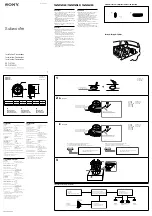
Page 10
8. Subwoofer Placement
Guide
So now that my system uses an integral subwoofer, how do I place it in
my studio for the best possible low frequency performance?
The low frequency response and efficiency of a subwoofer are heavily
influenced by the acoustics of the playback environment. More specifically, the
response is influenced by the room’s dimensional ratios, types of construction
and location of the subwoofer within that environment. You can significantly
improve the subwoofer’s in-room response and efficiency by experimenting
with various room placements until you find an optimum location.
When placing the subwoofer there are several general guidelines that should
be kept in mind. These include:
•
Every acoustic space is unique and experimentation is an important
key in finding the best possible location in your particular
environment.
•
A subwoofer becomes more acoustically efficient (has greater
output) as you move it closer to a room surface (e.g. wall or floor).
•
A subwoofer will give maximum output and maximum acoustic
excitement when it is located in a corner.
•
Under certain acoustic conditions corner locations are optimum; in
others they can excite multiple “room modes”, producing “muddy”
or “boomy” sound.
The following methods have been found to work successfully under
most conditions:
The first method described below doesn’t require any special test equipment.
It does require a pair of good ears and familiar broad-spectrum music material
– recordings with lots of energy across a wide frequency range (from low
to high). The recordings should be highly dynamic and be of relatively high
quality.
The second subwoofer placement method requires using a real time
analyzer – such as those made by Gold Line™ or The Audio Toolbox(TM) by
TerraSonde(TM). Although many home audio enthusiasts may not have access
to this equipment, if you are having a sound system or home theatre system
professionally installed, this information may be useful to the installer.
Method 1
Place the subwoofer at the main listening position and connect
and make sure it is properly connected to your receiver. Turn
on the CD or music source and make sure that the level of the
subwoofer has been raised high enough so that low frequencies
are not masked by the background noise in the room. Once you
have roughly balanced the level, between the sub and main
speakers, move around the room and pay careful attention to
where the spectral response is smoothest and has the greatest low
frequency extension, pay special attention to the corners and along
the walls. Also, make sure to pay attention to where the system has
its’ greatest impact and definition. You are not just listening for the
most boom, but rather where the bass is most accurate and natural
sounding. Remember, because the subwoofer is basically omni-
directional, the best spot for the subwoofer can be next to, or even
behind, the main monitoring area.
After finding the spot where the subwoofer has the best response
in the room, place the subwoofer in that location. Now, listen from
the main position and confirm that the subwoofers response is
similar to when the positions were reversed. If it is, then leave the
subwoofer in that location. If not, continue to experiment with the
subwoofer location until the most accurate and best response has
been achieved.
Method 2
Subwoofer placement using a real time analyzer – Such as those
made by Gold Line™ or The Audio Toolbox™ by TerraSonde™.
Place the subwoofer at the main listening position and connect the
subwoofer to your pink noise generator. Turn on your pink noise
generator and make sure that the level of the subwoofer has been
raised high enough so that low frequencies are not masked by the
background noise in the room. Now set the analyzer to 1/12 octave
resolution (or whichever setting provides the highest resolution
on your particular analyzer), real time mode and begin to take
measurements around the room. If the analyzer you are using has
the ability to do real time averaging, then use this function to better
analyze the spectral response.
As you walk around the room, be sure to pay careful attention to
where the spectral response is smoothest and has the greatest low
frequency extension, pay special attention to the corners and along
the walls. Remember, because the subwoofer is basically omni-
directional, the best spot for the subwoofer can be next to, or even
behind, the main monitoring area.
After analyzing the data and finding the spot where the subwoofer
has the best response in the room, place the subwoofer in that
location. Now, take some additional measurements from the
listening position and confirm that the subwoofers response is
similar to when the positions were reversed. If it is, then leave the
subwoofer in that location. If not, continue to experiment with the
subwoofer location until the smoothest and best response has
been achieved.
Additional Notes
It has been found that a subwoofers’ in-room response can sometimes be
improved by facing the drivers toward a wall. Again, experimentation is the
key to finding the best possible location.
Properly designed subwoofers generate tremendous energy, so
they may vibrate objects close to them. If you hear buzzing or
vibrating objects, make sure to try and dampen those objects.
Rattling, buzzing and other sympathetic resonances can make the
subwoofer localizable and therefore should be avoided. Using
a sine wave generator can be helpful in locating these acoustic
anomalies.


































